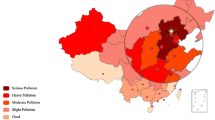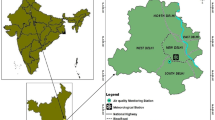Abstract
Fine particulate matter (PM2.5) is a complex air pollutant with numerous gaseous and solid constituents. PM2.5 possesses a significant hazard due to its ability to penetrate deep into the lungs, corrode the alveolar wall, and impair lung functions. Modeling the non-linear and dynamic time series of daily PM2.5 concentration remains a challenge. This study proposes a deep LSTM neural network to forecast accurate PM2.5 concentration in the Kathmandu valley. Correlation analysis illustrates that dew, minimum ambient temperature, maximum ambient temperature, and pressure are strongly correlated with PM2.5 concentration. Hence, five models are developed based on different input parameter combinations and are eventually evaluated to determine the best performing model. Model 2 with single-step prediction is the best performing deep LSTM model with RMSE of 13.04 μg/m3 and MAE of 10.81 μg/m3. The SARIMA model applied to the univariate PM2.5 data series illustrates the RMSE of 19.54 μg/m3 and MAE of 15.21 μg/m3 for the test data. Hence, the deep LSTM model with past PM2.5 data and dew as inputs is recommended to predict future PM2.5 concentration in the Kathmandu valley. The negative impact of PM2.5 concentration on public health can be minimized with efficient forecasting.












Similar content being viewed by others
Availability of data and material
Raw data of PM2.5 concentration, maximum and minimum ambient temperature, dew, humidity, pressure, and wind speed of Kathmandu valley is freely available on The World Air Quality Project’s open data platform (The World Air Quality Project 2019). Data will be made available upon request to the corresponding author.
References
Akaike H (1974) A new look at the statistical model identification. IEEE Trans Autom Control 19:716–723. https://doi.org/10.1109/TAC.1974.1100705
Alhanafy TE, Zaghlool F, Moustafa ASED (2010) Neuro fuzzy modeling scheme for the prediction of air pollution. J Am Sci 6:605–616
Box GE, Jenkins GM, Reinsel GC (2011) Time series analysis: forecasting and control. Wiley, Hoboken
Central Bureau of Statistics (2018) Population. https://cbs.gov.np/population/. Accessed 14 May 2020
Cheng Y, Zhang H, Liu Z, Chen L, Wang P (2019) Hybrid algorithm for short-term forecasting of PM2.5 in China. Atmos Environ 200:264–279. https://doi.org/10.1016/j.atmosenv.2018.12.025
Crouse DL, Peters PA, Hystad P, Brook JR, van Donkelaar A, Martin RV, Villeneuve PJ, Jerrett M, Goldberg MS, Pope CA III, Brauer M, Brook RD, Robichaud A, Menard R, Burnett RT (2015) Ambient PM2.5, O3, and NO2 exposures and associations with mortality over 16 years of follow-up in the Canadian Census Health and Environment Cohort (CanCHEC). Environ Health Perspect 123:1180–1186. https://doi.org/10.1289/ehp.1409276
Department of Transport Management (2020) Details of registered vehicles till end of Falgun of fiscal year 2075-76. https://www.dotm.gov.np/Files/NoticePDF/Vehicledatatill20762020-01-17_04-54-21-965.pdf. Accessed 14 May 2020
Di Q, Wang Y, Zanobetti A et al (2017) Air pollution and mortality in the Medicare population. N Engl J Med 376:2513–2522. https://doi.org/10.1056/NEJMoa1702747
Dockery DW, Pope CA (1994) Acute respiratory effects of particulate air pollution. Annu Rev Public Health 15:107–132
Dockery DW, Pope CA, Xu X, Spengler JD, Ware JH, Fay ME, Ferris BG Jr, Speizer FE (1993) An association between air pollution and mortality in six US cities. N Engl J Med 329:1753–1759. https://doi.org/10.1056/NEJM199312093292401
Environmental Protection Agency (2020) Air Topics. https://www.epa.gov/environmental-topics/air-topics. Accessed 14 May 2020
Francois C et al (2015) Keras. https://keras.io. Accessed 14 May 2020
Goyal P, Chan AT, Jaiswal N (2006) Statistical models for the prediction of respirable suspended particulate matter in urban cities. Atmos Environ 40:2068–2077. https://doi.org/10.1016/j.atmosenv.2005.11.041
Gupta P, Christopher SA (2009) Particulate matter air quality assessment using integrated surface, satellite, and meteorological products: Multiple regression approach. J Geophys Res-Atmos 114(D14). https://doi.org/10.1029/2008JD011496
Heald CL, Henze DK, Horowitz LW, Feddema J, Lamarque JF, Guenther A, Hess PG, Vitt F, Seinfeld JH, Goldstein AH, Fung I (2008) Predicted change in global secondary organic aerosol concentrations in response to future climate, emissions, and land use change. J Geophys Res-Atmos 113(D5). https://doi.org/10.1029/2007JD009092
Hochreiter S, Schmidhuber J (1997) Long short-term memory. Neural Comput 9:1735–1780. https://doi.org/10.1162/neco.1997.9.8.1735
Islam MM, Sharmin M, Ahmed F (2020) Predicting air quality of Dhaka and Sylhet divisions in Bangladesh: a time series modeling approach. Air Qual Atmos Health 13:607–615. https://doi.org/10.1007/s11869-020-00823-9
Katsouyanni K, Touloumi G, Spix C, Schwartz J, Balducci F, Medina S, Rossi G, Wojtyniak B, Sunyer J, Bacharova L, Schouten JP, Ponka A, Anderson HR (1997) Short term effects of ambient sulphur dioxide and particulate matter on mortality in 12 European cities: results from time series data from the APHEA project. Bmj 314(7095):1658–1663. https://doi.org/10.1136/bmj.314.7095.1658
Kukkonen J, Partanen L, Karppinen A et al (2003) Extensive evaluation of neural network models for the prediction of NO2 and PM10 concentrations, compared with a deterministic modelling system and measurements in central Helsinki. Atmos Environ 37:4539–4550. https://doi.org/10.1016/S1352-2310(03)00583-1
Li J, Sun CB, Liu XD et al (2009) Non-parameter statistical analysis of impacts of meteorological conditions on PM concentration in Beijing. Res Environ Sci 22:663–669
Li R, Mei X, Wei L, Han X, Zhang M, Jing Y (2019) Study on the contribution of transport to PM2.5 in typical regions of China using the regional air quality model RAMS-CMAQ. Atmos Environ 214:116856. https://doi.org/10.1016/j.atmosenv.2019.116856
Liang L, Wang Z, Li J (2019) The effect of urbanization on environmental pollution in rapidly developing urban agglomerations. J Clean Prod 237:117649. https://doi.org/10.1016/j.jclepro.2019.117649
Lin G, Cheng W, Xiao-lei WANG, Yan-ying WANG, Qian WANG (2013) Variation characteristics of fine particulate matter PM 2.5 concentration in three urban recreational forests in Hui Mountain of Wuxi City, Jiangsu Province of East China. Yingyong Shengtai Xuebao 24:2485–2493
Liu H, Duan Z, Chen C (2019) A hybrid framework for forecasting PM2.5 concentrations using multi-step deterministic and probabilistic strategy. Air Qual Atmos Health 12:785–795. https://doi.org/10.1007/s11869-019-00695-8
Loy-Benitez J, Vilela P, Li Q, Yoo C (2019) Sequential prediction of quantitative health risk assessment for the fine particulate matter in an underground facility using deep recurrent neural networks. Ecotoxicol Environ Saf 169:316–324. https://doi.org/10.1016/j.ecoenv.2018.11.024
Monn C (2001) Exposure assessment of air pollutants: a review on spatial heterogeneity and indoor/outdoor/personal exposure to suspended particulate matter, nitrogen dioxide and ozone. Atmos Environ 35:1–32. https://doi.org/10.1016/S1352-2310(00)00330-7
Panday AK, Prinn RG (2009) Diurnal cycle of air pollution in the Kathmandu Valley, Nepal: observations. J Geophys Res-Atmos 114(D9). https://doi.org/10.1029/2008JD009777
Regmi RP, Kitada T, Kurata G (2003) Numerical simulation of late wintertime local flows in Kathmandu valley, Nepal: Implication for air pollution transport. J Appl Meteorol 42:389–403. https://doi.org/10.1175/1520-0450(2003)042%3C0389:NSOLWL%3E2.0.CO;2
Sarriera JM, Sehmi GS (2019) Transport pollution: Some practical solutions for developing countries. World Bank Blogs. https://blogs.worldbank.org/transport/transport-pollution-some-practical-solutions-developing-countries. Accessed 14 May 2020
Shakya KM, Rupakheti M, Shahi A, Maskey R, Pradhan B, Panday A, Puppala SP, Lawrence M, Peltier RE (2017) Near-road sampling of PM 2.5, BC, and fine-particle chemical components in Kathmandu Valley, Nepal. Atmos Chem Phys 17:6503–6516. https://doi.org/10.5194/acp-17-6503-2017
The World Air Quality Project (2019) Air quality open data platform: worldwide COVID-19 dataset. https://aqicn.org/data-platform/token/#/. Accessed 14 May 2020
The World Bank (2016) Death in the air: air pollution causes money and lives. https://www.worldbank.org/content/dam/infographics/780xany/2016/sep/WB_cost-of-pollution-infographic-ENGLISH_for_web.jpg. Accessed 14 May 2020
The World Bank and Institute for Health Metrics and Evaluation (2016) The cost of air pollution: strengthening the economic case for action. http://documents.worldbank.org/curated/en/781521473177013155/pdf/108141-REVISED-Cost-of-PollutionWebCORRECTEDfile.pdf. Accessed 14 May 2020
Tong W, Li L, Zhou X, Hamilton A, Zhang K (2019) Deep learning PM2.5 concentrations with bidirectional LSTM RNN. Air Qual Atmos Health 12:411–423. https://doi.org/10.1007/s11869-018-0647-4
Wang Y, Kloog I, Coull BA, Kosheleva A, Zanobetti A, Schwartz JD (2016) Estimating causal effects of long-term PM2.5 exposure on mortality in New Jersey. Environ Health Perspect 124:1182–1188. https://doi.org/10.1289/ehp.1409671
World Health Organization (2013) Health effects of particulate matter: policy implications for countries in eastern Europe, Caucasus and central Asia. Copenhagen, Denmark
World Health Organization (2014) 7 million premature deaths annually linked to air pollution. https://www.who.int/mediacentre/news/releases/2014/air-pollution/en/. Accessed 14 May 2020
World Health Organization (2018) Ambient (outdoor) air pollution. https://www.who.int/news-room/fact-sheets/detail/ambient-(outdoor)-air-quality-and-health. Accessed 14 May 2020
Xing YF, Xu YH, Shi MH, Lian YX (2016) The impact of PM2.5 on the human respiratory system. J Thorac Dis 8:E69–E74 https://dx.doi.org/10.3978%2Fj.issn.2072-1439.2016.01.19
Zhou JX (2005) Changes of several main contaminations and some meteorological elements. J Appl Meteorol Sci 16:123–127
Acknowledgments
The authors would like to express sincere gratitude to The World Air Quality Project for providing necessary data to complete the study.
Author information
Authors and Affiliations
Corresponding author
Ethics declarations
Conflict of interest
The authors declare that they have no conflict of interest.
Code availability
Keras library with TensorFlow backend is utilized to implement the proposed deep LSTM neural network. The code is executed in the Google Colaboratory. The code will be made available upon request to the corresponding author.
Additional information
Publisher’s note
Springer Nature remains neutral with regard to jurisdictional claims in published maps and institutional affiliations.
Rights and permissions
About this article
Cite this article
Dhakal, S., Gautam, Y. & Bhattarai, A. Exploring a deep LSTM neural network to forecast daily PM2.5 concentration using meteorological parameters in Kathmandu Valley, Nepal. Air Qual Atmos Health 14, 83–96 (2021). https://doi.org/10.1007/s11869-020-00915-6
Received:
Accepted:
Published:
Issue Date:
DOI: https://doi.org/10.1007/s11869-020-00915-6




